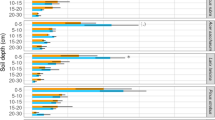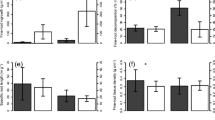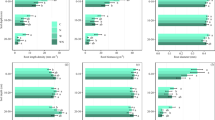Abstract
Aims
The morphological traits of fine roots change with forest succession and soil weathering. However, low tree species diversity in boreal forests may limit plastic responses of the roots to soil nutrient loss. We tested whether pine trees (Pinus sylvestris L.) exhibit root plasticity to change fine root allocation to deeper soil horizons in response to varying degree of podzolization.
Methods
We compared root biomass in two sand dune chronosequences (aluminium (Al)/iron (Fe) oxide-poor coarse-textured sand vs. oxide-rich fine-textured sand) in Estonia.
Results
We found that faster podzolization in coarse-textured soil promotes migration of Al/Fe oxides and phosphorus (P) into deeper horizons and reshapes the depth distribution of fine root biomass. A decrease in P availability in the coarse-textured soil profile increases fine root biomass and length in both the organic and mineral horizons. In the fine-textured old soil, fine root distribution increases in the mineral soil (especially, spodic horizon) rich in oxide-bonded P.
Conclusion
Pine roots exhibit two forms of plasticity in low-diversity boreal forests – changing root morphological traits and changing depth distribution of root biomass, depending on the abundance of Al and Fe oxides and the depth distribution and dominant form of P.







Similar content being viewed by others
References
Aoki M, Fujii K, Kitayama K (2012) Environmental control of root exudation of low-molecular-weight organic acids in tropical rainforests. Ecosystems 15:1194–1203
Blakemore LC, Searle PL, Daly BK (1987) Methods for chemical analysis of soils. NZ Soil Bureau Scientific Report 80
Bolan NS (1991) A critical review on the role of mycorrhizal fungi in the uptake of phosphorus by plants. Plant Soil 134:189–207
Butterfield BJ, Bradford JB, Munson SM, Gremer JR (2017) Aridity increases below-ground niche breadth in grass communities. Plant Ecol 218:385–394
Chapin III FS, Matson PA, Vitousek P (2011) Principles of terrestrial ecosystem ecology. Pp. 63-90. Springer Science & Business Media
Canadell J, Jackson RB, Ehleringer JB, Mooney HA, Sala OE, Schulze ED (1996) Maximum rooting depth of vegetation types at the global scale. Oecologia 108:583–595
Fritze H, Pietikäinen J, Pennanen T (2000) Distribution of microbial biomass and phospholipid fatty acids in Podzol profiles under coniferous forest. Eur J Soil Sci 51:565–573
Fujii K, Aoki M, Kitayama K (2012) Biodegradation of low molecular weight organic acids in rhizosphere soils from a tropical montane rain forest. Soil Biol Biochem 47:142–148
Fujii K, Hayakawa C, Inagaki Y, Ono K (2019) Sorption reduces the biodegradation rates of multivalent organic acids in volcanic soils rich in short-range order minerals. Geoderma 333:188–199
Funakawa S, Mambu K, Hirai H, Kyuma K (1993) Pedogenetic acidification process of forest soils in northern Kyoto. Soil Sci Plant Nutri 39:677–690
Giesler R, Lundström US (1993) Soil solution chemistry—the effects of bulking soil samples and spatial variation. Soil Sci Soc Am J 57:1283–1288
Hidaka A, Kitayama K (2009) Divergent patterns of photosynthetic phosphorus-use efficiency versus nitrogen-use efficiency of tree leaves along nutrient-availability gradients. J Ecol 97:984–991
Hodge A (2004) The plastic plant: root responses to heterogeneous supplies of nutrients. New Phytol 162:9–24
Holdaway RJ, Richardson SJ, Dickie IA, Peltzer DA, Coomes DA (2011) Species-and community-level patterns in fine root traits along a 120000-year soil chronosequence in temperate rain forest. J Ecol 99:954–963
IUSS Working group WRB (2015) World Reference Base for soil resources. In-ternational soil classification system for naming soils and creating legends for soil maps. World soil resources reports no. 106. FAO, Rome
Jackson RB, Canadell J, Ehleringer JR, Mooney HA, Sala OE, Schulze ED (1996) A global analysis of root distributions for terrestrial biomes. Oecologia 108:389–411
Jones DL, Dennis PG, Owen AG, Van Hees PAW (2003) Organic acid behavior in soils–misconceptions and knowledge gaps. Plant Soil 248:31–41
Jongmans AG, Van Breemen N, Lundström U, Van Hees PAW, Finlay RD, Srinivasan M, Olsson M (1997) Rock-eating fungi. Nature 389(6652):682–683
Lambers H, Raven JA, Shaver GR, Smith SE (2008) Plant nutrient-acquisition strategies change with soil age. Trends Ecol Evol 23:95–103
Landeweert R, Hoffland E, Finlay RD, Kuyper TW, van Breemen N (2001) Linking plants to rocks: ectomycorrhizal fungi mobilize nutrients from minerals. Trends Ecol Evol 16:248–254
López-Bucio J, Cruz-Ramırez A, Herrera-Estrella L (2003) The role of nutrient availability in regulating root architecture. Curr Opin Plant Biol 6:280–287
Lundström US, van Breemen N, Bain D (2000) The podzolization process. Rev Geoderma 94:91–107
Ma Z, Guo D, Xu X, Lu M, Bardgett RD, Eissenstat DM, Hedin LO (2018) Evolutionary history resolves global organization of root functional traits. Nature 555(7694):94–97
Makita N, Hirano Y, Mizoguchi T, Kominami Y, Dannoura M, Ishii H, Kanazawa Y (2011) Very fine roots respond to soil depth: biomass allocation, morphology, and physiology in a broad-leaved temperate forest. Ecol Res 26:95–104
Makita N, Hirano Y, Sugimoto T, Tanikawa T, Ishii H (2015) Intraspecific variation in fine root respiration and morphology in response to in situ soil nitrogen fertility in a 100-year-old Chamaecyparis obtusa forest. Oecologia 179:959–967
McCormack ML, Adams TS, Smithwick EA, Eissenstat DM (2012) Predicting fine root lifespan from plant functional traits in temperate trees. New Phytol 195:823–831
McKeague JA, Day JH (1966) Dithionite- and oxalate-extractable Fe and Al as aids in differentiating various classes of soils. Can J Soil Sci 46:13–22
Ostonen I, Püttsepp Ü, Biel C, Alberton O, Bakker MR, Lõhmus K, Majdi H, Metcalfe D, Olsthoorn AFM, Pronk A, Vanguelova E, Weih M, Brunner I (2007) Specific root length as an indicator of environmental change. Plant Biosyst 141:426–442
Ostonen I, Helmisaari H, Borken W, Tedersoo L, Kukumägi M, Bahram M, Lindroos A, Nöjd P, Uri V, Merilä P, Asi E, Lõhmus K (2011) Fine root foraging strategies in Norway spruce forests across a European climate gradient. Glob Chang Biol 17:3620–3632
Öhlinger R (1995) Maximum water-holding capacity. In: Schinner F, Öhlinger R, Kandeler E, Margesin R (eds) Methods in soil biology. Springer, Berlin, pp 385–386
Pote DH, Daniel TC, Nichols D, Sharpley AN, Moore PA, Miller DM, Edwards DR (1999) Relationship between phosphorus levels in three Ultisols and phosphorus concentrations in runoff. J Environ Qual 28:170–175
Rosling A, Landeweert R, Lindahl BD, Larsson KH, Kuyper TW, Taylor AFS, Finlay RD (2003) Vertical distribution of ectomycorrhizal fungal taxa in a podzol soil profile. New Phytol 159:775–783
Ryser P (1996) The importance of tissue density for growth and life span of leaves and roots: a comparison of five ecologically contrasting grasses. Funct Ecol 10:717–723
Smits MM, Bonneville S, Benning LG, Banwart SA, Leake JR (2012) Plant-driven weathering of apatite–the role of an ectomycorrhizal fungus. Geobiology 10:445–456
Tobner CM, Paquette A, Messier C (2013) Interspecific coordination and intraspecific plasticity of fine root traits in north American temperate tree species. Front Plant Sci 4:242
Treseder KK, Vitousek PM (2001) Effects of soil nutrient availability on investment in acquisition of N and P in Hawaiian rain forests. Ecology 82:946–954
Turner BL, Condron LM (2013) Pedogenesis, nutrient dynamics, and ecosystem development: the legacy of TW Walker and JK Syers. Plant Soil 367:1–10
Uselman SM, Qualls RG, Lilienfein J (2007) Fine root production across a primary successional ecosystem chronosequence at Mt. Shasta, California. Ecosystems 10:703–717
Valverde-Barrantes OJ, Freschet GT, Roumet C, Blackwood CB (2017) A worldview of root traits: the influence of ancestry, growth form, climate and mycorrhizal association on the functional trait variation of fine-root tissues in seed plants. New Phytol 215:1562–1573
Vilumaa K, Ratas U, Tõnisson H, Kont A, Pajula R (2017) Multidisciplinary approach to studying the formation and development of beach-ridge systems on non-tidal uplifting coasts in Estonia. Boreal Environ Res 22:67–81
Van Hees PA, Jones DL, Godbold DL (2002) Biodegradation of low molecular weight organic acids in coniferous forest podzolic soils. Soil Biology and Biochemistry, 34(9):1261–1272
Vitousek, P.M. (2004) Nutrient cycling and limitation: Hawai'i as a model system. Princeton University Press
Walker TW, Syers JK (1976) The fate of phosphorus during pedogenesis. Geoderma 15:1–19
Wardle DA, Walker LR, Bardgett RD (2004) Ecosystem properties and forest decline in contrasting long-term chronosequences. Science 305(5683):509–513
Wang X, Zabowski D (1998) Nutrient composition of Douglas-fir rhizosphere and bulk soil solutions. Plant Soil 200:13–20
Zadworny M, McCormack ML, Żytkowiak R, Karolewski P, Mucha J, Oleksyn J (2017) Patterns of structural and defense investments in fine roots of scots pine (Pinus sylvestris L.) across a strong temperature and latitudinal gradient in Europe. Glob Chang Biol 23:1218–1231
Acknowledgments
We devote this manuscript to the late Dr. Akira Osawa. This work was financially supported by the Green Network of Excellence (GRENE) Arctic Climate Change Project and by the Estonian Research Council Grant (IUT18–9, Environmental Changes and Their Effects on the Coastal Landscape of Estonia: Past, Present and Future–ENCHANTED). There is no conflict of interest.
Author information
Authors and Affiliations
Corresponding author
Additional information
Responsible Editor: François Teste.
Publisher’s note
Springer Nature remains neutral with regard to jurisdictional claims in published maps and institutional affiliations.
Rights and permissions
About this article
Cite this article
Fujii, K., Makita, N., Kamara, M. et al. Plasticity of pine tree roots to podzolization of boreal sandy soils. Plant Soil 464, 209–222 (2021). https://doi.org/10.1007/s11104-021-04928-7
Received:
Accepted:
Published:
Issue Date:
DOI: https://doi.org/10.1007/s11104-021-04928-7




